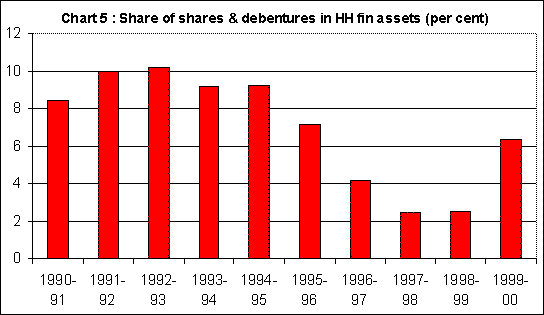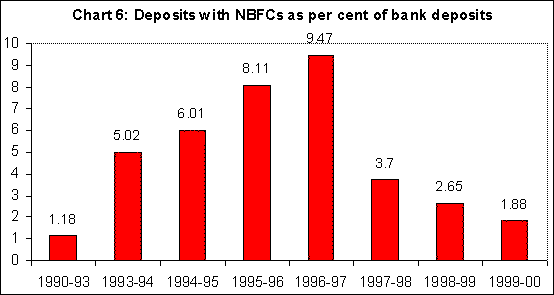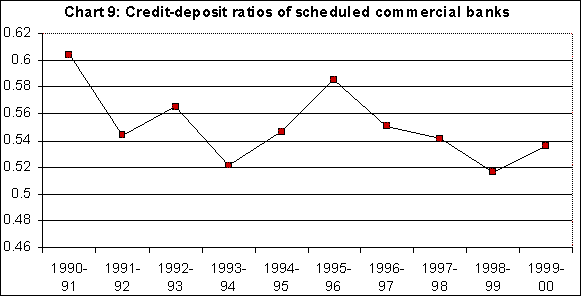Themes > Features
19.06.2001
Small Savings and Interest Rates : The Real Story
One of the favourite predictions of the proponents of financial
liberalisation measures in the 1990s was that the eventual result of such
reforms would be reductions in real interest rates. It was argued that
there would be an initial rise in such rates to redress the excessively
low interest rates created by policies of "financial repression". In fact
this was argued to be both necessary and welcome because it was supposed
to lead to higher rates of domestic saving as well.
But thereafter the greater access to capital, especially from
international markets, was supposed to imply that Indian entrepreneurs
would face lower real rates of interest. This in turn would obviously act
as a spur to investment. Thus financial liberalisation was seen as a means
of generating lower real interest rates and higher real investment rates.
This has not occurred. In fact, neither have investment and savings rates
increased significantly over the 1990s,
nor have real rates of interest
gone down over the course of the decade. Chart 1 show the overall savings
ratio, the household savings rate and the financial savings of households
as proportions of GDP.

This shows that gross domestic savings rose slightly in the mid-1990s (a
period when, interestingly, real interest rates were relatively low) and
have declined slightly thereafter, to levels that are more or less
comparable to those of the beginning of the decade. This decline from the
mid-1990s has also been associated with a decline in household financial
savings.
Meanwhile, nominal interest rates have fallen, but real interest rates
have shown no such tendency and have in fact risen quite sharply from the
middle of the decade, to levels well in excess of 8 per cent. This is
clear from Chart 2, in which the representative nominal interest rate is
taken to be the State Bank of India's Advance Rate. The real interest rate
is that minus the rate of change in the Wholesale Price Index. (The other
nominal interest rates facing entrepreneurs, such as the term lending
rates of the non-bank financial institutions, tend to be substantially
higher.)

Clearly, this is something which requires explanation. Even if the very
optimistic argument of the liberalisers concerning the effect of capital
inflows on domestic real interest rates were not accepted, there would
still have been some expectation that access to more forms of capital
would have meant some decline in real interest rates for domestic
investors. The apparent imperviousness of real interest rates to any such
pressure therefore deserves much closer consideration.
One of the arguments that has recently gained a lot of attention, and is
increasingly cited by a number of proponents of the financial sector
reforms, relates to the fact that small savings by households constitute
an important part of the overall savings in the economy. According to this
argument, the Government, in order to attract small savings in the form of
Public Provident Fund, Post Office deposits, National Savings Schemes and
other such schemes to finance its own expenditure, has kept interest rates
on such schemes relatively high.
In addition, of course, such schemes have the advantage of appearing to be
risk-free besides offering the added incentive of tax benefit up to a
certain limit. For the household sector, this has increasingly become an
attractive alternative to bank deposits. For this reason, banks are forced
to maintain high deposit rates and this is why their lending rates remain
high despite the financial liberalisation measures.
Another explanation that has been offered relates to the supposed
inefficiency of banks, due to "inadequate liberalisation" and the fact of
public ownership, which is supposed to have meant that the spreads between
deposit and lending rates has remained high. According to this position,
the dominance of the nationalised banking sector has meant that the
benefits of lower deposit rates are not passed on the borrowers, and so
investors continue to face high rates.
It is worth considering the validity of these arguments in more detail,
because they are now commonly advanced as likely without careful
assessment of the available evidence. Consider first of all the argument
relating to small savings and the higher returns to households from such
savings.
For this to be accepted, it must be shown that small savings with the
government have replaced bank deposits, at least at the margin, in total
household savings. But Chart 3, which shows the proportion of bank
deposits in the total financial assets of households, shows no significant
time trend over the 1990s. In fact, on average the share of bank deposits
has been substantially higher in the last three years of the decade (at
more than 38 per cent) than in the first three years of the decade (at
only 32 per cent).

Meanwhile, as Chart 4 indicates, the share of small savings has indeed increased slightly over the 1990s. However, this increase is not marked when compared to the beginning of the decade (or with the last few years of the 1980s) and represents more of a recovery to the earlier shares. Bu what is more to the point is that such changes have definitely not been at the expense of bank credit. Rather, the share of household savings held as shares and debentures, which had reached 10 per cent in 1992-93 following the stock market boom immediately after the initial liberalisation, has declined sharply (barring the final year of the decade) to only around 2 per cent in 1998-99 (Chart 5).


So it is mainly the greater uncertainty in the stock market which has driven small investors back to the more secure forms of savings such as Public Provident Fund and so on, and reduced exposure to the riskier forms of saving. It is worth noting that recent fiscal measures, in terms of reduction in interest rates on small savings and tax concessions such as relief in terms of capital gains tax, are designed to cause such investors to turn back to shares and debentures and reduce their holding of public instruments of small savings. The rates of interest on such instruments, some of which are described in Table 1, are now lower than they have ever been in the 1990s.
|
Data for Table 1 |
||||
|
Interest rates on Small Savings Schemes |
||||
|
Rate of Interest per Annum Since : |
||||
| April 1991 | April 1992 | Sept. 1993 | Jan 2000 | |
|
Post
Office Time Deposit |
905-11.5 | 12-13.5 | 10.5-12.5 | 8-10.5 |
| PPF 1968 | 12 | 12 | 12 | 11 |
| NSS 1992 | 11 | 11 | 11 | 10.5 |
| NSC VII Issue | 12 | 12 | 12 | 11.83 |
The evident public disaffection with riskier savings instruments is also evident from Chart 6, which shows that deposits of the public with non-bank financial companies, which grew as a proportion of bank deposits over the middle of the 1990s, have since declined quite substantially in such terms.

This means that the argument that small savings have replaced bank
deposits at the margin, or among the preferences of households, is not
substantiated by the evidence. Bank deposits are as important as they have
been from the beginning of the decade; in fact more than they were in the
previous decade. Rather, it is the desire to move out of stock
market-based instruments and investments in non-bank financial companies
that often promise very attractive if risky returns, that has been
responsible for the increase in small savings from the middle of the
1990s. This in turn means that high interest rates on such small savings
cannot be the culprit in terms of finding an explanation for why bank
lending rates have remained high in real terms.
The other explanation, which revolved around high (and possibly
increasing) spreads on deposit rates because of bank inefficiency or lack
of sufficient competition, also does not find validation in the data. As
Chart 8 shows, the spread between deposit rates for term deposits of one
to three years' duration, and the State Bank of India's Advance Rate, has
actually declined quite sharply since the peak reached in 1993-94. This is
corroborated by other evidence which suggests that the net interest income
(spread ) as a proportion of total assets of banks declined for al major
groups of banks over this period. In fact, the decline was most marked for
public sector banks, which implies that, if anything, their "efficiency"
increased over this period.

What has happened is that because of the high proportion of term deposits
in commercial banks' deposit portfolios, they are effectively stuck still
paying high rates of interest on a significant part of the deposits.
Meanwhile, depressed investment conditions and the fact that the prime
borrowers now have access to capital from abroad in the form of GDRs, ADRs
and ECBs have implied less demand for credit from the preferred borrowers.
In the circumstances, banks are relying on increasing certain forms of
high-value lending such as consumer credit, and on safe government
securities which offer relatively high rates of return because the
interest rates on most government debt remain high.
Therefore the process seems to be as much demand-driven as anything else,
in terms of banks finding difficulty in identifying desired borrowers at
the prevailing rates of interest. That is why bank holding of government
securities has increased substantially in recent years, rising from 26 per
cent of total deposits at the beginning of the decade to 34 per cent at
the end of the decade. And, as Chart 9 shows, credit deposit ratios have
fallen from the already low levels of the early 1990s, to abysmally low
levels of just above 50 per cent.

This is more than an interesting irony, given the reduction of the
Statutory Liquidity Ratio as part of the financial reforms of the early
1990s. This measure was designed to free commercial banks from necessarily
holding more than one-third of their assets in the form of government
securities, since the SLR was lowered to 26 per cent in 1993. It turns out
that the current position is that commercial banks are holding more than
Rs. 100,000 crore as government securities. This amounts to 35 per cent of
the deposits, which is well in excess of the minimum holding that is
currently required, of 25 per cent. In fact it is the same as the level
that existed prior to the financial reform measures !
At the time when they were first implemented, these financial
liberalisation measures were widely described as working to increase the
access of private borrowers to bank credit. Instead, what appears to have
occurred is that banks are now voluntarily holding government securities
(for which the government is paying much higher interest rates !) and
credit to the private sector appears to have been further reduced in
proportion to deposits. So, while this measure did operate to make
borrowing more expensive for the Central Government and therefore
increased its interest burden, it has certainly not led to greater access
of the private sector to bank credit.
In this context, why then have interest rates not declined in real terms ?
If banks are hard put to find desirable domestic borrowers in a context of
domestic recession, and instead prefer to hold government securities, then
why are real interest rates not driven down further ?
The answer lies in government policy, in a combination of fiscal policy
and financial liberalisation which has put upward pressure on interest
rates and affected the structure of government borrowing. Two financial
liberalisation measures of the early 1990s have been of special
significance in terms of government borrowing.
The first was the decision to reduce and eventually to do away with
deficit financing as a means of financing the fiscal deficit. It is
impossible to justify this in rational economic terms, especially given
the widespread recognition that some amount of deficit financing (which is
the cheapest form of borrowing available to the government) has no
inflationary implications. The second was the reduction of the Statutory
Liquidity Ratio, which was already mentioned.
Both of these measures had the effect of forcing the government into more
expensive open market borrowing, which in turn has been a significant
cause of the increase in the interest burden of the Central Government.
Meanwhile, the increasing resource crunch faced by the State Governments
has also forced them into more market borrowing on even more expensive
terms, since they are seen as less preferred borrowers than the Central
Government.
Indeed, while many complain that the problem is that of the past burden of
public debt, a major problem is actually that of higher interest rates on
public borrowing. These have contributed to a situation which is now
perilously close to that of Ponzi finance, in which the government is
borrowing mainly in order to pay interest.
With this background, the interest rate structure of Central Government
debt becomes absolutely crucial in determining the overall level of
interest rates. While interest rates on government debt have been reduced
in the recent past, real rates remain high. It could even be suggested
that these high real interest rates provided by the government have become
necessary to shore up the banking system in the current recessionary
atmosphere.
The problem is that this is not just an issue of fiscal and monetary
management. It amounts to a huge burden on present and future taxpayers
and potential recipients of public services which are cut because of
resource constraints, given the large drain on the public exchequer
because of interest payments.
This need to maintain high real interest rates in turn becomes necessary
because the other aspect of financial liberalisation has meant that the
government must necessarily be concerned with the need to attract or
maintain capital in the country and prevent capital flight. Thus financial
liberalisation, far from reducing real interest rates, has been the major
contributory factor to their remaining at high levels.
© MACROSCAN 2001